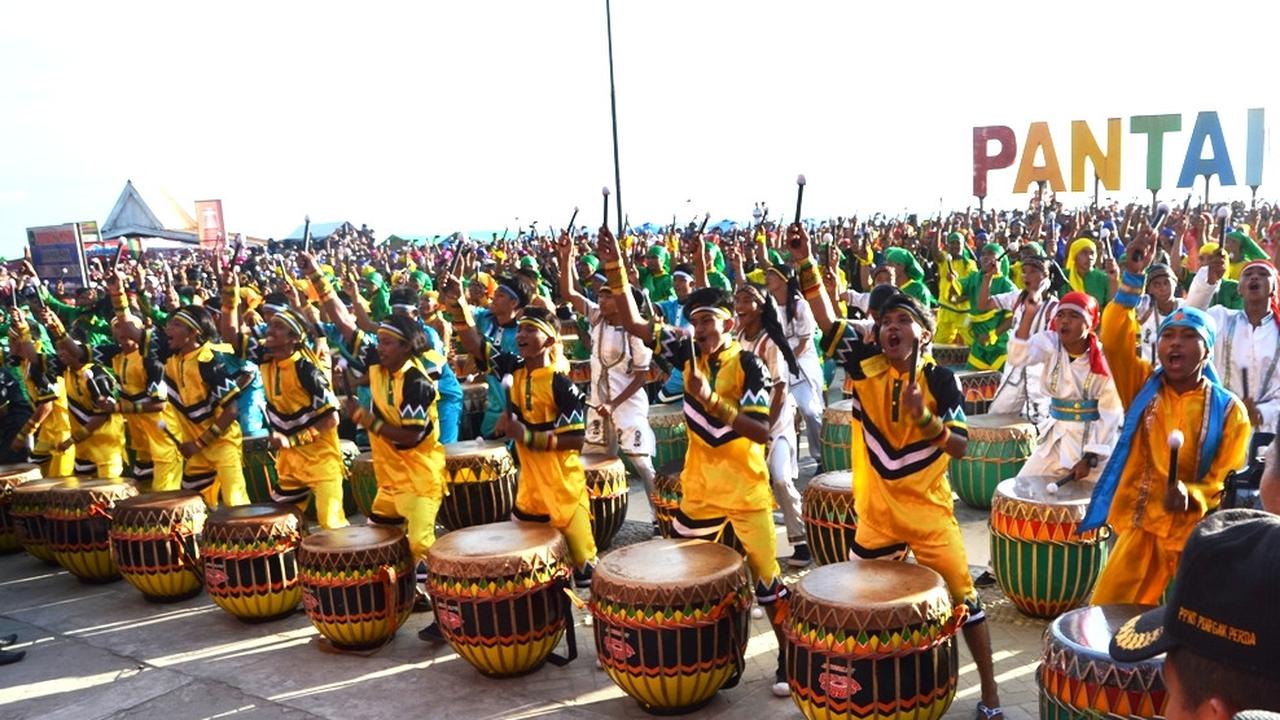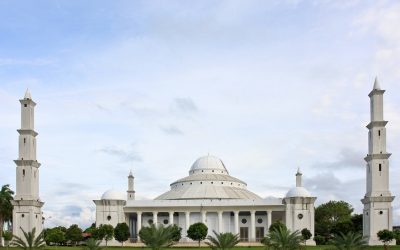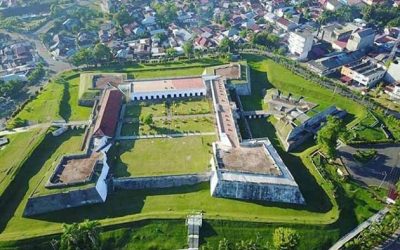Home / Batik Regions – Western Indonesia – Southern Sumatra – Bengkulu / Tabut Festival
Destinasi Budaya
Resapi kekayaan budaya bangsa!
Tabut Festival
Bengkulu regional government holds annual the Tabut Festival that takes place in the Panjang Beach. This festival is held for ten consecutive days to celebrate the Islamic new year based on the lunar calendar. The festival also demonstrates various performing arts such as local traditional Dhol music performance. This percussion drum is played in a group of people in parallel with the performance of Bengkulu traditional dances.
Tourist Attractions in Bengkulu
At Taqwa Grand Mosque
Bengkulu also offers spiritual tourism with historical nuances and
Fort Marlborough
Fort Marlborough in Bengkulu was once built by the British colonial era during
Bengkulu
Batik Motifs
Kaganga Tanah Rejang
If Batik Besurek combines Arabic calligraphy motifs, then the Kaganga batik takes
Besurek Rafflesia
The term “Basurek” refers to a textile that contains letters or inscriptions
Besurek Rembulan
This batik illustrates praise for God who created the wonderful universe
Discover
Indonesian
Batik
Motifs
Lok Baintan Floating Market
As you can imagine, the most authentic thing is that you can buy things and even
Gonggong Siput
Gonggong (Strombus Turturella) is one type of sea snail found around
Burung Bidadari
Bidadari birds are endemic birds in Halmahera. This motif represents an
Biji Kopi
The coffee seeds motif illustrates the pride of local coffee specialities in
Bintik Tujuh
The Bintik Tujuh (Seven Dots) motif has 7 white spots and green color gradation as
Prada Papua
The word “Prada” in the Javanese-Indonesian dialect means a batik textile that
Angsa Duo
According to legend, the Angso duo batik motif is a pair of swans that are believed to have led Princess
Bekantan Pakis
This motif represents Pakis Haji (Polystichum setiferum), an endemic plant in
Desa Na Tolu
The Desa Na Tolu characteristic pattern symbolizes the Batak philosophy of existence and
Buketan Bali
The Balinese bouquet (Buketan Bali) is a floral arrangement and the name is
Kerawang Tegak Aceh
The Vertical Upright (Kerawang Tegak) Motif symbolizes a person who has a strong
Tengkawang Ampiek
With its many advantages, the Dayaks use this leaf in ritual ceremonies. This plant is a symbol of
Tenun Bima
The motifs are adopted from Bima woven textile. This pattern has received a great
Durian Pecah
Broken Durian motifs depict the foundation of faith. The second half signifies the mastery of
Singayaksa
The Singayaksa motif comes from the name of a place where Sultan Hasanuddin used to
Kaganga Tanah Rejang
If Batik Besurek combines Arabic calligraphy motifs, then the Kaganga batik takes
Daun Lada Hitam
The black pepper motif represents the main commodity of Bangka Belitung
Leuit Sijimat
This motif reflects the daily activities of the Baduy tribe in Banten. The main ornaments of batik motif consist of:
Rumah Mamuju
the Batik motif illustrates the house of Mamuju King with the stairs, located on the left of the wooden stage house
Bale Lumbu
This motif signifies the welfare of the ancient Sasak society. Bale also symbolizes the
Tangerang Herang
Tangerang Herang motif is a symbol of Tangerang city. The Tangerang Herang batik motif consists of
Gurdo Solo
Gurdo or garuda bird is the mount of the Indian god Vishnu. As the Sun Bird,
Kuda Kupang
Horses symbolize wealth. It contains noble values of virtuous characters that bring
Lontara
The Lontara script itself is a typical ancient script of Bugis and Makassar communities. History records that
Gedhog Kembang Waluh
a combination of Javanese cultural motif of the Majapahit kingdom (XII-XIV century) with
Pinawetengan
The Pinawetengan Batik pattern was taken from a prehistoric inscription in
Hiu Taliyasan
Indonesia is also home to the world’s largest fish, the whale shark (Rhincodon typus). Hiu Taliyasan refers to
Gajah Way Kambas
The motif illustrates the Lampung’s natural reserve, the Way Kambas. it also symbolizes
Wakatobi
It symbolizes the coastal beauty of the Wakatobi island and the symbol of Patra symbolizes
Karawo Mahkuta
Mahkuta refers to Gorontalo’s traditional crown. It represents noble characters of
Gentala Arasy
Built as high as 80 meters, the tower also highlights the historical side of
Dayak Kamang
Kamang motif is generally found in the Dayak tribe shield because it is believed to
Daun Sirih
This motif illustrates betel leaves that are used by Lombok communities as traditional
Besurek Rembulan
This batik illustrates praise for God who created the wonderful universe
Insang Ikan
Insang refers to the gills of the fish. This is a typical pattern of Malay ethnic who inhabits
Salakanagara
Salakanagara batik motif illustrates the first kingdom in the Betawi land
Tikar Natuna
The Tikar Natuna motif is adapted from the traditional making of pandanus mats in
Keluak Daun Pakis
The word “Keluak” is a Minang language which means twisted or tangled. The Motif of
Ukir Sentani
The Ukir motif is a batik motif that is inspired by various traditional Sentani wood carvings
Mahkota Siger
Siger is the crown of a noblewoman in ancient time. It is a symbol of femininity, strength, and
Kawung
The Kawung motif was created by Sultan Agung Hanyokrokusumo (1593 – 1645) as a symbolic gift for
Enggang Dayak
Local people beliefs that hornbills are an incarnation of the Commander of the Birds. It has supernatural
Ake Patra
Ake is related to the divinity and the composition of the universe. It is a symbol of
Sandeq
Sandeq Boat is a symbol of the maritime importance of the West Sulawesi region. The greatness of
Manguni Minahasa
Manguni is identified as the symbol of the Minahasa people. Manguni is known as a
Sero Tangga
The Sero Tangga illustrates an endearing feeling and sacrifices of a person to fulfil
Pattimura
Pattimura is the name of an Indonesian hero who fought against colonialism in
Taiganja
Taiganja is a precious gold pendant that shows the social status of the Kaili family. It is
Kasih Tak Sampai
‘Kasih Tak Sampai’ is an idiom in the Indonesian language which refers to
Gamolan
This motif illustrates Gamolan, a bamboo musical instrument of Lampung that is
Bultiya
The word ‘Bultiya’ is an acronym of the three major tribes in North Kalimantan, namely
Dayak Taghol
Dayak Taghol has a distinctive style of four curved lines and small dots. This motif represents
Srimanganti
The name of the Srimanganti motif is derived from Palace’s hallway that connects to
Kaharingan
The Kaharingan or ‘tree of life’ based on the Dayak tribes’ belief system. This tree symbolizes
Teguh Bersatu
This batik motif shows the strength of the people of Kupang. It also represents a sense of
Gonggong Beruntun
This motif illustrates that a person should maintain a positive attitude and
Gorga Simeol-Meol
The Gorga Simeol-meol is a pattern of plant tendrils. it is regarded as a symbol of longevity and
Tampuk Manggis Sasirangan
The motif illustrates the philosophy of the mangosteen fruit, which is
Lipaq Sabe
Lipaq Saqbe contains a simple geometric classical motif with various flower decorations. This textile is
Sekar Jati
Sekar means flower and Jati refers to teak trees that symbolizes a strong mental character that
Raja Ampat
Raja Ampat motif represents the marine life at Raja Ampat archipelago in
Pala Salawaku
This motif illustrates the unique weapons of the Maluku region, namely
Sido Mulyo
Sidomulyo is one of the classical motifs, which is specifically used for the bride’s costume in
Sekomandi
Its philosophical meaning is the eternal union which refers to a saying “until death do us part”
Merak Ngeram
The hatching peacock motif has a very deep meaning which refers to the sacrifice and
Malinau Cultural Festival
You will witness a unique competition that might not be found other than in
Wirasat
Wirasat or divine inspiration is a gift from God. This inspiration is symbolized by
Pucuk Rebung Riau
Pucuk Rebung symbolizes heart determination in achieving goals, good luck, and
Tabir Tanjung
Tanjung flower is a type of Cherry tree flower, which is commonly found in



